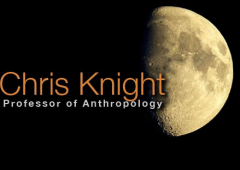Most anthropologists have tacitly assumed that human culture was established by men. The ‘Man the Hunter’ myth has dominated palaeoanthropology, now, almost since the inception of the discipline. Through the 1960s and 1970s, it was taken as self-evident that the sexual division of labour, with males going away hunting and bringing home the bacon, emerged millions of years ago in a process linked with the evolution of bipedalism, tool-making and the unusually large human brain.
Category: Origins of Culture
Interview with Chris Knight in Ready Steady Book
Painted Ladies (by Kate Douglas, New Scientist)
It all began when women set out to fool their men with a dab of make-up.
As We Know It: Coming to Terms With an Evolved Mind
Marek Kohn on the Knight/Power/Watts theory of human origins.
Ochre comes in shades of yellow, orange, red and brown; the core of it is the iron red of ferric oxide. Together with manganese dioxide, which is densely black, it offered Palaeolithic hominids a palette covering the spectrum of fire, from flame to charcoal.
Up to about 110,000 years ago, they only dabbled occasionally. Then, in southern Africa, ochre seems to have coloured their whole lives. It is present in ‘copious’ quantities at every cave and rock shelter that contains relics of occupation from this period. This was a monochrome explosion, based almost entirely on red ochre, and particularly upon strong reds, rather than orange or brown shades. The collectors of pigment made little or no use of the deposits of manganese ore and magnetite, a black iron oxide, which were available in some areas. According to Ian Watts of University College, London, who has made the study of prehistoric ochre his own, 99.5 per cent of all known African Middle Stone Age pigment is iron oxide, and 94 per cent contains a red streak.
Download As We Know It: Coming to Terms With an Evolved Mind [PDF 380KB]
Culture, cognition and conflict.
Chris Knight
A Cognitive Theory of Cultural Meaning, by Claudia Strauss & Naomi Quinn, 1997. Cambridge: Cambridge University Press; ISBN 0-521-59409-X hardback, £50 & US$64.95; ISBN 0-521-59541-X paperback £16.95 & US$24.95, 323 pp.
How the Mind Works, by Steven Pinker, 1997. London: Penguin; ISBN 0-713-99130-5 hardback, £25, 660 pp.
Archaeologists study outcomes of past cognitive strategies. We might better reconstruct these if we fathomed how human cognition works, when and how it evolved – and the nature of its relationship with technology, language and culture. If there exists some novel, elegant and parsimonious theory which addresses such issues, then that is good news. So I looked forward to reading these books. Continue reading “Culture, cognition and conflict.”
